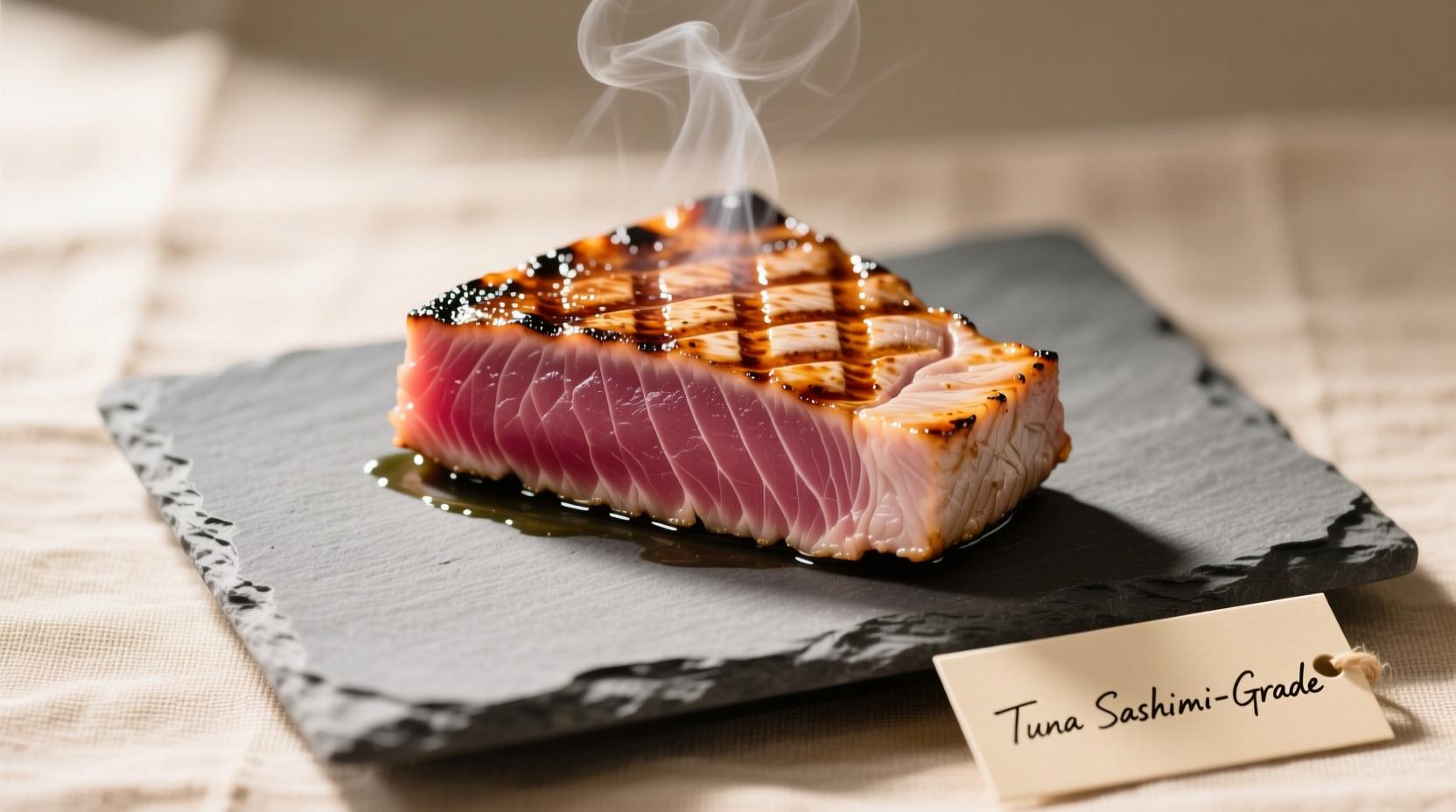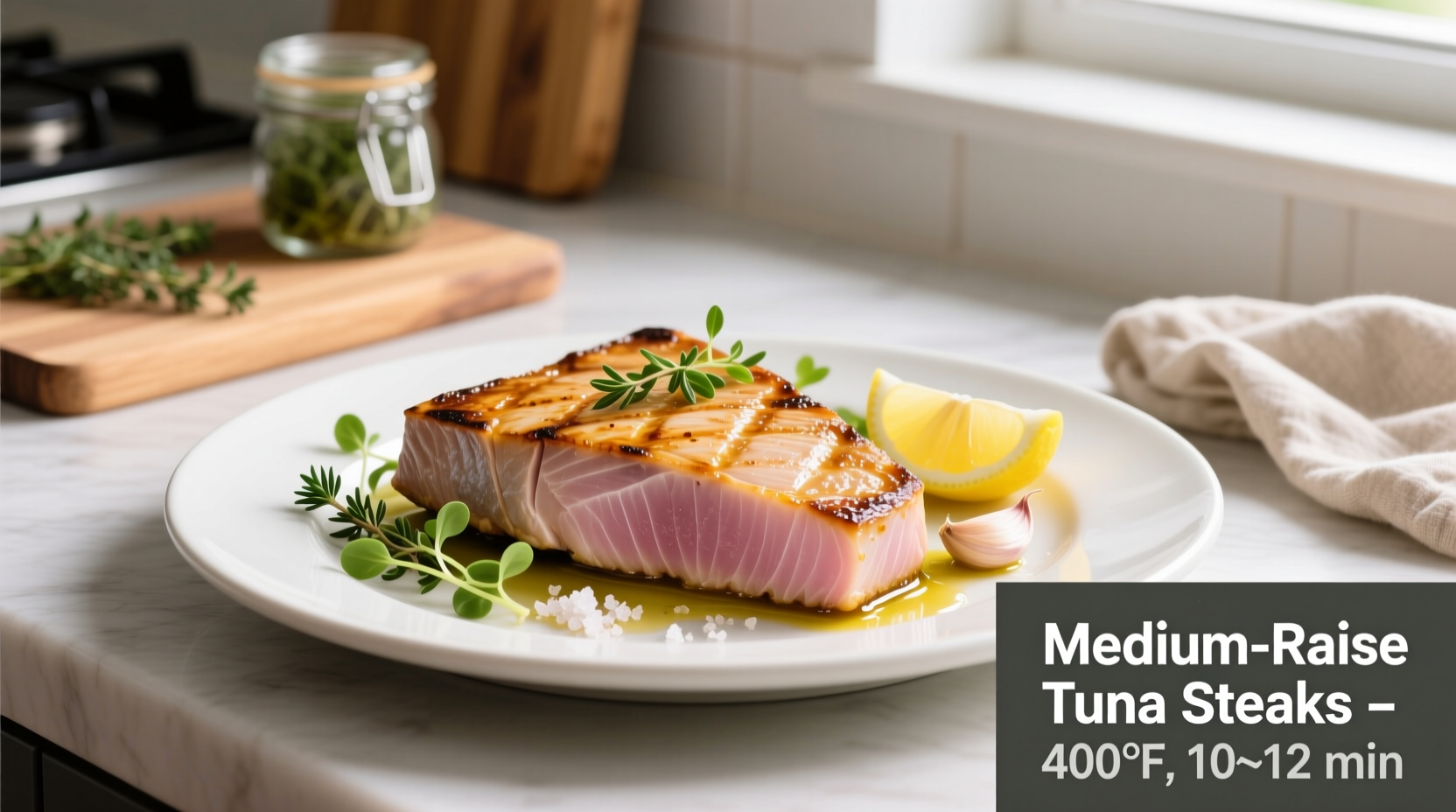To cook tuna steaks in the oven, preheat to 425°F (220°C), season 1-1.5 inch thick steaks with salt, pepper and optional olive oil, and bake for 8-12 minutes until internal temperature reaches 125°F for rare or 135°F for medium-rare. Let rest 5 minutes before serving. This foolproof method delivers restaurant-quality results with minimal effort.
Perfectly cooked tuna steaks shouldn't be dry, tough, or overdone. The oven method gives you precise control over doneness while creating a beautiful sear and tender interior. Whether you're a beginner or experienced home cook, this guide eliminates guesswork with exact timing, temperature guidelines, and professional chef techniques you can trust.
Why Oven-Baked Tuna Steaks Beat Other Methods
While many recipes suggest pan-searing, oven-baking provides consistent results without requiring constant attention. The gentle, even heat prevents the common problem of overcooked exteriors with raw centers. According to the FDA's seafood safety guidelines, cooking fish to proper internal temperature is crucial for food safety while preserving texture.
| Cooking Method | Consistency | Required Attention | Texture Results |
|---|---|---|---|
| Oven Baking | Highly consistent | Low (set timer) | Even doneness throughout |
| Pan Searing | Variable | High (constant monitoring) | Risk of overcooked exterior |
| Grilling | Depends on heat control | Moderate to high | Can dry out easily |
Essential Preparation Checklist
Before you start cooking tuna steaks in the oven, gather these essentials:
- Tuna steaks: 1-1.5 inches thick (thicker cuts work best for oven method)
- Oven temperature: 425°F (220°C) - hot enough for searing, gentle enough for even cooking
- Thermometer: Instant-read thermometer (critical for perfect doneness)
- Seasoning basics: Kosher salt, freshly ground black pepper, optional olive oil or sesame oil
- Pan: Oven-safe skillet or baking dish
Step-by-Step Oven Cooking Process
1. Prepare Your Tuna Steaks
Remove tuna from refrigerator 15-20 minutes before cooking. Pat thoroughly dry with paper towels - moisture is the enemy of proper searing. Season generously with salt and pepper on all sides. For extra flavor, add a light coating of olive oil or sesame oil.
2. Preheat Oven and Pan
Place your oven-safe skillet in the oven while it preheats to 425°F (220°C). A hot pan creates an immediate sear when the tuna hits the surface. This critical step prevents sticking and develops flavor through the Maillard reaction.
3. Cooking Timeline for Perfect Results
Follow this precise timeline based on thickness. The USDA food safety guidelines recommend fish reach 145°F, but tuna is best served rare to medium-rare:
- 1-inch thick: 6-8 minutes total
- 1.25-inch thick: 8-10 minutes total
- 1.5-inch thick: 10-12 minutes total
Cook until internal temperature reaches:
- 120-125°F for rare (deep red center)
- 130-135°F for medium-rare (warm red center)

4. Resting Is Non-Negotiable
Remove tuna from oven when 5°F below your target temperature. Tent loosely with foil and rest for 5 minutes. During this time, the internal temperature will rise slightly (carryover cooking), and the fibers will relax, resulting in more tender, juicy meat. Skipping this step causes juices to escape when cut.
Critical Success Factors Most Guides Miss
Oven Temperature Accuracy Matters
Most home ovens have inaccurate thermostats. Use an oven thermometer to verify actual temperature. A 25-degree variance can mean the difference between perfect and overcooked tuna. The Culinary Institute of America's Professional Chef textbook emphasizes that "oven temperature accuracy is the most overlooked factor in consistent cooking results. "
Thickness Determines Timing
Don't rely on time alone - use a thermometer. Tuna steaks vary in thickness even within the same package. The FDA's Fish and Shellfish Hazards and Control Guidance specifies that thickness directly impacts required cooking time for food safety.
Context Boundaries: When This Method Works Best
This oven method excels with:
- Fresh or properly thawed frozen tuna steaks
- Steaks at least 1 inch thick (thinner cuts overcook too easily)
- When you want consistent results without constant monitoring
Avoid this method for:
- Very thin tuna slices (use pan-searing instead)
- When you want a heavy crust (finish with a quick pan sear)
- Low-quality, previously frozen tuna with ice crystals
Proven Serving Suggestions That Elevate Your Dish
Pair your perfectly cooked tuna with these complementary elements:
- Sauces: Wasabi aioli, citrus beurre blanc, or simple soy-ginger drizzle
- Sides: Roasted asparagus, jasmine rice, or mixed greens with citrus vinaigrette
- Garnishes: Microgreens, toasted sesame seeds, or thinly sliced scallions
Chef Thomas Keller's Ad Hoc at Home cookbook notes that "simple preparations showcase the quality of the fish itself" - don't overwhelm the delicate tuna flavor with heavy sauces.
Troubleshooting Common Tuna Steak Problems
Problem: Dry, Overcooked Tuna
Solution: Reduce cooking time by 2-3 minutes and check temperature earlier. Remember that carryover cooking adds 5-10°F after removal from oven. For future attempts, consider lowering oven temperature to 400°F for thicker cuts.
Problem: Raw Center After Cooking
Solution: Pat tuna completely dry before cooking and ensure your pan is properly preheated. If needed, finish with 1-2 minutes in a hot skillet to sear the exterior without overcooking the center.
Problem: Fishy Taste
Solution: This indicates less-than-fresh tuna. Always smell tuna before purchasing - it should have a clean, ocean-like scent, not strong or ammonia-like. Marinate briefly in lemon juice or milk to neutralize any off-flavors.
Expert Tips for Next-Level Results
- Freeze tuna briefly (20-30 minutes) before slicing for cleaner cuts
- Score the edges to prevent curling during cooking
- For added flavor, rub with miso paste or dukkah before cooking
- Let seasoned tuna sit 10 minutes before cooking to allow salt to penetrate











 浙公网安备
33010002000092号
浙公网安备
33010002000092号 浙B2-20120091-4
浙B2-20120091-4